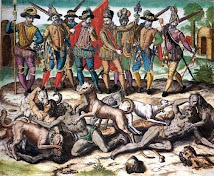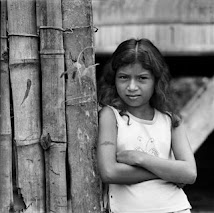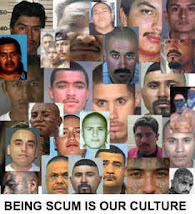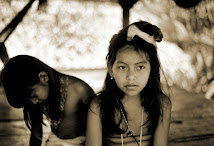

Native Americans (also Aboriginal Peoples, Aboriginal Americans, American Indians, Amerindians, Amerind, Indians, First Nations, First Peoples, Native Canadians, or Indigenous Peoples of America) are those peoples indigenous to the Americas, living there prior to European colonization. This term encompasses a large number of distinct tribes, states, and ethnic groups, many of them still enduring as political communities.
The terms "Amerindian" and "Indian", both of which are derivatives of "American Indian" (as is "Amerind", though this term is more popular in linguistic circles), are not necessarily completely synonymous with "Native American". Although all Amerindians are Native Americans, not all Native Americans are Amerindians. "Amerindian" relates to a mega-group of people spanning the Americas that are related in culture and genetics, and are quite distinct from the later arriving Eskimos (Inuit, Yupik, and Aleut peoples native to Alaska and arctic Canada). The latter share their cultural and genetic commonality with other arctic peoples not native to the American continent, such as those from arctic Russian Siberia.
The same distinction is made in Canada, where the term First Nations applies only to Native Canadians who belong to the same cultural and genetic mega-group of Amerindians mentioned above. The Canadian First Nations specifically exclude the Inuit and Inuvialuit in the north, although these are included in the terms "First Peoples" and "Native Canadians". First Peoples are enshrined in the Canadian Constitution with various treaty rights, some long established and many more currently under negotiation.
The term Native American may be construed to either include or exclude the Metis of Canada and the Mestizos and Zambos of Latin America.
Based on anthropological and genetic evidence, scientists generally agree that most Native Americans descend from people who migrated from Siberia across the Bering Strait, between 17,000 11,000 years ago.
The European colonization of the Americas forever changed the lives and cultures of the Native Americans. In the 15th to 19th centuries, their populations were ravaged, by the privations of displacement, by disease, and in many cases by warfare with European groups and enslavement by them. The first Native American group encountered by Columbus, the 250,000 Arawaks of Haiti, were enslaved. Only 500 survived by the year 1550, and the group was extinct before 1650.
In the 15th century Spaniards and other Europeans brought horses to the Americas. Some of these animals escaped and began to breed and increase their numbers in the wild. Ironically, the horse had originally evolved in the Americas, but the last American horses, (species Equus Scotti and others) died out at the end of the last ice age. The re-introduction of the horse had a profound impact on Native American culture in the Great Plains of North America. This new mode of travel made it possible for some tribes to greatly expand their territories, exchange goods with neighboring tribes, and more easily capture game.
From the outset European colonists had, at best, lived in an uneasy truce with the Native Americans. While the groups sometimes cooperated, the Natives were inexorably displaced from the most favorable land, and frequently resisted this process with violence.Although in recent years it has become popular to assert that Native Americans learned scalping from Europeans, historical evidence suggests that scalping by Native Americans had been practiced long before contact with Europeans.
The first reported case of white men scalping Native Americans took place in New Hampshire colony on February 20, 1725.
Four Nations of the Iroquois Confederacy sided with the British and the Tories in the American Revolutionary War. The colonists were especially outraged by the Wyoming Valley Massacre and the Cherry Valley Massacre, which occurred in 1778.
In the 19th century, the Westward expansion of the United States incrementally expelled large numbers of Native Americans from vast areas of their territory, either by forcing them into marginal lands farther and farther west, or by outright massacres. U
nder President Andrew Jackson, Congress passed the Indian Removal Act of 1830, which forced the Five Civilized Tribes from the east onto western reservations, primarily to take their land for settlement. The forced migration was marked by great hardship and many deaths. Its route is known as the Trail of Tears.
On January 31, 1876 the United States government ordered all remaining Native Americans to move into reservations or reserves. This, together with the near-extinction of the American Bison which many tribes had lived on, set about the downturn of Prairie Culture that had developed around the use of the horse for hunting, travel and trading.
Current Status
Military defeat, cultural pressure, confinement on reservations, forced cultural assimilation, outlawing of native languages and culture, forced sterilizations, termination policies of the 1950s, and 1960s, and slavery have had deleterious effects on Native Americans' mental and physical health. Contemporary health problems include poverty, alcoholism, heart disease, diabetes, and New World Syndrome.
As recently as the 1960s, Indians were being jailed for teaching their traditional beliefs. As recently as the 1970s, the Bureau of Indian Affairs was still actively pursuing a policy of "assimilation", the goal of which was to eliminate the reservations and steer Indians into mainstream U.S. culture. Even their lands are perhaps no longer safe; as of 2004, there are still claims of theft of Indian land for the coal and uranium it contains.






































.jpg)






.jpg)







No comments:
Post a Comment